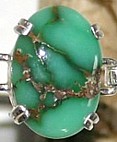
Treatment of Emerald, Aquamarine and Morganite Beryls

 |
Treatment of Emerald, Aquamarine and Morganite Beryls
|
 |
Beryl
is a large and important family of gemstones which includes both aquamarine and emerald. When free of color causing impurities or any
radiation induced coloration beryl is actually colorless. The presence of the elements
chromium and vanadium give the green coloration of emerald, iron gives both yellow and the
blue of aquamarine, whereas morganite and the Utah red beryl are colored by the presence
of manganese. A
large percentage of the aquamarine which is used in jewelry comes out from the ground in a
greenish blue shade. At one time, this more
greenish shade was the preferred color for aquamarine gems, however the winds of fashion
have shifted in recent decades and blue is now the preferred color. In order to remove the yellowish under him tone
that makes the aquamarine appear green, gentle heating is needed. Temperatures between 250 and 400°C are best. Only a few hours time is needed to effect the
change. Care must be taken to heat the stones
slowly as the stones do have some sensitivity, and it is possible to create heat induced
fractures. Where desired, additional yellow coloration in beryl gems can be induced
through irradiation. This is basically the
reverse of the process of heat treatment noted above which removes the same yellow
coloration. Some
morganite which tends towards orange or salmon colors can be changed through the same heat
treatment noted above to remove the yellow element, leaving a pure pink. The temperatures and necessary precautions are the
same as noted for aquamarine. |
|
Emerald
is not normally treated by heat or radiation, but there are numerous treatments to improve
the appearance of emerald gems. Perhaps the
biggest problem with emerald is its tendency to be cracked and flawed. Clean, transparent
and well colored emeralds are both rare and valuable.
For centuries men have treated emerald gems with oils, waxes or plastics to
fill in the open spaces and cracks, making the gem appear more transparent and attractive.
A thorough cleaning followed by immersion in the fluids under a strong vacuum is a
technique used to draw the fluids into the stone. At
times, these substances have also been dyed green in order to enhance the green coloration
of the emerald. A large percentage of all
emeralds in commercial jewelry have been treated by some version of this technique.
Unfortunately, the materials which are used to fill the voids are not nearly as strong or
stable as the emerald itself. Stones which
were weak through the presence of cracks and other flaws do not become appreciably
stronger through the process of filling them, and any structural weakness that was
originally present still remains. As a
result, these stones are far more subject than one would expect to damage the impact or
other blows while being worn, especially when used for rings. This type of filling
treatment should always be disclosed to the buyer. A
new or more high-tech method has been used in recent years for the enhancement of emerald
gems. Techniques have been developed to
actually grow over coatings of a synthetic, man made deep green emerald onto pale emerald
and other beryl gems. The coatings are
generally thin and often can be easily noted when specific types of testing equipment are
used. |
|
|
Want to know a little bit more about this crazy prospector guy? Well, here's a little bit more about me, and how I got into prospecting: Chris' Prospecting Story